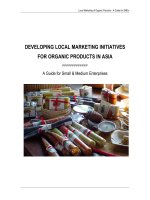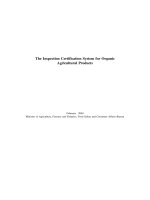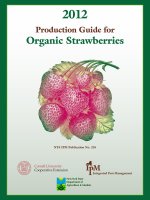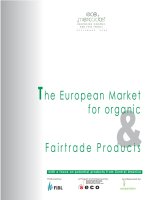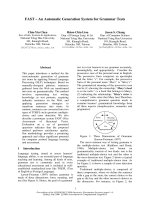The Inspection Certification System for Organic Products pot
Bạn đang xem bản rút gọn của tài liệu. Xem và tải ngay bản đầy đủ của tài liệu tại đây (214.13 KB, 6 trang )
The Inspection Certification System
for Organic Products
Name of registered
certifying body
April 2012
Ministry of Agriculture, Forestry and Fisheries,
Food Safety and Consumer Affairs Bureau
-1-
Ⅰ. Establishment of inspection certification system for organic products
1. Amid growing concerns of consumers over food safety and health
consciousness, flooding of the labellings such as "organic", "reduced amount
of pesticide", etc. became a hindrance to consumers' appropriate choice.
"Guidelines for O rganic Agricultural Products a nd Specially Cultivated
Agricultural Products" were established in 1992, and the proper labeling had
been tried, but organic products were not labelled appropriately, criteria of
organic production were not unified and the labeling was confused as ever
because of no legal force of the guidelines.
2. On the international front, the Codex Alimentarius Commission ( Joint
FAO/WHO Food Standards Programme) had started to discuss for the
establishment of the guideline of organic products. In 1999, the Codex
Commission adopted the "Guidelines for the Production, Processing, Labeling
and Marketing of Organically Produced Foods"( GL32-1999).
3.In the light of these circumstances, the Japanese Agricultural Standards( JAS
standards) for organic plants and organic processed foods were established
and labelling of oraganic products were made to be proper in accordance with
revision of the Law Concerning Standardization and Proper Labeling of
Agricultural and Forestry Products ( JAS Law) in 1999. (Since then, JAS
standards for organic livestock products and feeds were established.)
4. The JAS standards for organic products were laid out in compliance with
the Codex Guidelines. In such other countries as United States, EU, etc. those
organic standards were also laid out in compliance with the Codex Guidelines.
[Labeling regulations]
1 With regards to organic plants and organic processed foods of plant origin,
confusion had been seen over name labels, and since there was fears that
this would become a grave hindrance to general consumers choice,
government ordinances was specified for commodities for which it is
particularly necessary to plan appropriate name labeling.
2 Therefore, in order to fulfill Japanese Agricultural Standards for organic
plants and Japanese Agricultural Standards for organic processed foods of
plant origin, items except to which the certified operators attache Organic
JAS logos cannot be labeled as "organic" or another designation which
would be confused with this ( effective as of April 1, 2001).
Prohibit misleading
labeling to products
without Organic
JAS logos
Organic tomato
Organic s pinach
Organic carrot
-2-
Ⅱ. Inspection certification system for organic products
[Organization of inspection certification system]
1. Registration of registered certification bodies
The Minister of Agriculture, Forestry and Fisheries takes applications and,
conducts assessments based on the standards specified by JAS law, and
registers certifying bodies.
2. Certification of certified operators
The registered certifying body accepts certification applications from farms
producing organic plants and processed foods manufacturers, and awards
certification after conducting assessments based on the Technical Criteria for
Certifying.
For certification, document reviews and on-site assessments are conducted
to confirm:
a. Fields or processing plants meet organic production criteria ( organic JAS
standards)
b. Production management, and documentation of production management
are conducted appropriately so that production will conform with said
standards.
3. Inspection of certified operators
In order to confirm that producers and manufacturers are conducting
production in accordance with organic JAS standards after being certified by a
registered certifying body, inspections shall be conducted at least once a year.
4. Grading by certified operators
Certified farms producing organic plants and manufacturers of processed
foods, grade the products they produce/manufacture based on the records etc.
of the production/manufacturing process, attach the Organic JAS logos
themselves and supply their products to the marketplace.
Minister of Agriculture, Forestry and Fisheries
Application Registration Assessment Report of①②⑥⑤
of accreditation certification status
Registered certifying body
Application Certification Certification Application③④ ④③
Assessment⑥
Production Farm Manufacturer
Grading Grading⑦⑦
Retailer
Consumer
-3-
Ⅲ. Japanese Agricultural Standards for organic products etc.
(1) Japanese Agricultural Standards for organic plants
1. Process of enactment
The Japanese Agricultural Standards for organic plants were laid out in
compliance with the "Guidelines for Production, Processing, Labeling and
Marketing of Organically Produced Foods" adopted at t he 1999 Codex
Alimentarius Commission, and after resolutions by the Council for the
Standards for Agricultural and Forestry Products, were notified by the Minister
of Agriculture, Forestry and Fisheries based on the January 2000 revised JAS
law.
2. Details
The Japanese Agricultural Standards for organic plants in addition to stating
production principles for organic agricultural products, also stipulate criteria of
production methods and system of labeling of names.
(a) Criteria of production methods
1. Fields, Collection area
2. Seeds or seedlings to be used in fields
3. Manuring practice in fields
4. Cultivation sites, Fungus spawn, Cultivation management in cultivation
sites
5. Control of noxious animals and plants in fields or cultivation sites
6. General management, Management of raising seedlings
7. Management concerning harvest, transportation, selection, processing,
cleaning, storage, packaging and other post-harvest processes
(b) System of labeling of names
The labels "有機農産物" (which means organic plant in Japanese.) ,"有
機栽培農産物" (which means organically grown plant in Japanese.) ,"有機
○○" (which means organic ○○ in Japanese.),"オーガニック○○"
(which means organic ○○ in Japanese.),etc. are stipulated.
(General names of plants shall be filled in "○○.")
○ Principles of organic plants
"To sustain and enhance the natural recycling in agriculture, the
productivity of the farmland derived from the soil properties shall be
generated by avoiding the usage of the chemical synthetic fertilizer and
agricultural chemicals, and the organic agricultural products shall be produced
in fields adopting such c ultivation management method a s reducing the load
derived from the agricultural production on the environment as much as
possible."
○ Criteria of production methods for organic plants
1. Soil fertility shall be maintained and enhanced by compost, etc and over a
period of at least 2 years before the sowing or planting( at least 3 years
before the first harvesting of perennial plants) , synthetic fertilisers and
agricultural chemicals shall not be used, in principle.
2. Seeds or seedlings shall not be produced by recombinant DNA technology.
○ Organic JAS Logo
Name of registered
certifying body
-4-
(2) Japanese Agricultural Standards for organic livestock products
1. Process of enactment
The Japanese Agricultural Standards for organic livestock products were
laid out in compliance with the "Guidelines for Production, Processing,
Labeling and Marketing of Organically Produced Foods" adopted at the 1999
Codex Alimentarius Commission, and after a resolution by the Council for the
Standards for Agricultural and Forestry Products, were notified by the Minister
of Agriculture, Forestry and Fisheries in October 2005.
2. Principles of organic livestock products
Organic livestock products are, in principle, manufactured from organic
livestock raised in deference to their physiological and behavioral needs, on
the basis of provision of providing feeds produced by reducing pressure on the
environment as much as possible and the avoidance of use of veterinary drugs,
to sustain and enhance the natural cyclical function of agriculture.
(3) Japanese Agricultural Standards for organic processed foods
1. Process of enactment
The Japanese Agricultural Standards for organic processed foods were laid
out with the JAS for organic plants in 2000. Along with the establishment of
the J AS for organic livestock products, the JAS for org a nic processed foods
were reviced to include organic processed foods for organic livestock products
in 2005.
2. Principles of organic processed foods
To produce organic processed foods by processing methods utilizing
physical and biological functions, avoiding the use of chemically synthesized
food additives and chemical agents, and by preserving the characteristics of
organic plants and organic livestock products as ingredients in the
manufacturing and processing.
○ Criteria of production methods for organic livestock products
1. Organic feeds shall be mainly provided.
2. Livestocks shall be raised by minimizing stress through pasturing in
open-air, etc.
3. Antibiotics, etc. shall not be used in order to prevent desease.
4. Recombinant DNA technology shall not be used.
note) The JAS for organic feeds were established in order to garantee the
organic feature with regard to purchased feeds.
○ Criteria of production methods for organic processed foods
1. The use of chemically synthesized food additives and chemical agents shall
be avoided as much as possible.
2. Weight of organic plants, organic processed foods and organic livestock
products shall be no less than 95% o f the weight of all ingredients of organic
processed foods (except for salt, water and processing aids) .
3. Organic processed foods shall be produced or processed in the facelities
controlled to avoid exposure to chemical agents
4. Recombinant DNA technology shall not be used.
-5-
Ⅳ. Import of organic products from abroad
1. The two types of methods
(1) Method of attaching the Organic JAS logos to and distributing organic
products produced or manufactured by foreign manufacturers that have
received certification from a registered Japanese or overseas certification
body.
(2) Method of having importers, that have received certification from a
registered Japanese certification organization, attach the Organic JAS
logos to and distribute the products( limited to organic plants and organic
processed foods of plant origin) .(Article 15-2 of the JAS Law)
2. Equivalence
The thinking behind 1 (2), a certificate or a copy thereof issued by
governmental organizations of the export countries which are considered to be
on equivalent level with the Japanese Agricultural Standard's grading system
shall be attached. (Article 15-2, Paragraph 2 of the JAS Law)
Equivalence in 1(2) requires the existence of
1) guarantee measures for the grading system and its appropriate
application and system for securing reliability assurance of grading labels and
that the contents of the system are of the same level as the JAS system;
2) standards regarding the concerned agricultural products which are
equivalent with those of the Japanese Agricultural Standards.
3. Current status
With regards to organic agricultural products, the 27 EU countries,
Australia, United States, Argentina, New Zealand and Switzerland are noted as
possessing equivalence in Article 15-2, currently ( April 2012).
(1) Method of attaching the Organic JAS logos to and distributing organic
products produced or manufactured by foreign manufacturers that have
received certification from a registered Japanese or overseas certification
body.
(2) Method of having importers, that have received certification from a
registered Japanese certification body, attach the Organic JAS logos to
and distribute the products.
